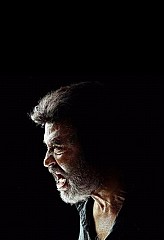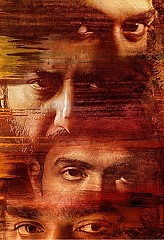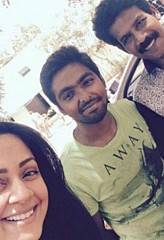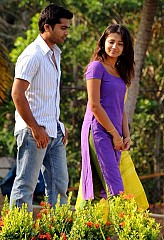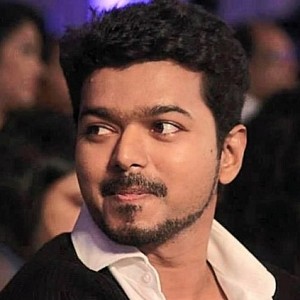
After the advent of movies, we have learned to stack and rekindle our memories in a uniquely cinematic way. We reminisce as if they are shot as a scene from a sequence from our past. And, in such a sequence, a group of 11-year- old boys were noisily searching for their seats in the darkness of a suburban cinema theatre years ago. The movie, Devaraagam, directed by Bharathan, had already started rolling and the tiny heads of the boys interrupting the view irritated the already seated audience.
Then, amid the chaos, the hero in the movie slipped into a memory, like we do in real life, of a song sequence in which a group of young women danced with lamps in their hands. The whole street was lit with lamps and there she was; magnificence personified with a lamp in her hand and the light in her eyes. As if a metaphorical reference to her otherworldly beauty, director Bharathan jump cut her close-up shot to a stunning close-up of a deity adorned with a garland and ornaments.
Be it the name, or the appearance in real life, or the characters she played onscreen, the title Sridevi was always synonymous with the word 'goddess'. She enacted every facet of Indian women in her fifty-year-long career spanning all the major film industries in India. Beginning as a child artist in 1969, she played crucial roles alongside Rajinikanth and Kamal Haasan in the South throughout the 70s and conquered Bollywood with back-to-back blockbusters in the 80s.
Movies like Julie, Moondru Mudichu, Varumaiyin Niram Sivappu, Pathinaru Vayadhinile, Sigappu Rojakkal, Moondram Pirai, Premabishekam, Sadma, Chandni, Mr India, and Devaraagam made her the most adored female actor, and eventually the first lady superstar of Indian cinema. She established deadly onscreen combos with stars like Jeetendra and Kamal Haasan which worked for almost a decade with a number of blockbusters. The rise and reign of Sridevi imply the complex and often mysterious bond between Indian viewers and the movie stars.
In India, where the society is layered with diverse aspirations and dreams of various classes, a superstar is a common factor, who almost single-handedly shoulders the weight of the dreams and aspirations of their heydays. At a psychological level, this connection works like that between a deity and devotee; at an emotional level, this connection is the safety valve of the viewers to vent out their frustrations; at a financial level, this connection makes the industry keep running on its wheels.
Sridevi was the first female actor in Indian cinema who cracked the male supremacy in all these three connections. It is a feat achieved not just by a good looking face, a smile, the support of godfathers, or elastic dance moves, but with an insurmountable effort demanding patience, skill, endurance, grace, intuitiveness, innovation, and most importantly, courage. She wasn't a queen by default, because of some crown wearing king husband, she was a queen on her own terms and by her own merits.
This is an exhausting proposition for a female actor in a predominantly patriarchal industry. Yet, Sridevi hasn't just lived the lives Indian women cherished, but also lived the lives of those women who are cherished by Indian men, for almost five decades. It is interesting to notice that she kept that representative potential of her roles when picked up the perseverant mother character in the 2012 movie, English Vinglish, for a comeback after a hiatus.
In Mira Nair’s 1988 movie Salaam Bombay, a girl in a brothel dances to the tunes of Sridevi’s iconic dance number Hawa Hawai from Mr India. On a conclusive knock, that made Sridevi a superstar; to instil dreams into dreamless minds, to fill empty hearts with the joy of living, to give form to our amorphous desires, to love for the loveless, and live the lost lives of a million of men and women onscreen. With sheer bravery and determination, she delved into unknown terrains and languages only to surface with a handful of cinematic dreams, or rather, memories. Adieu!
Behindwoods is not responsible for the views of columnists.
FACEBOOK COMMENTS
OTHER LATEST BEHINDWOODS COLUMNS
RAGESH DIPU'S OTHER COLUMNS
- The Blackness of Kaala and Portrait of the Superstar as an Actor
- Chekka Chivantha Vaanam - Why we yearn for a Mani Ratnam film
- Why Naachiyar is not a Typical Bala Film, but More
- From Kolaveri to Priya Prakash Varrier, And How #hashtags Grow Bigger Than the Movies!
- From Mahesh to the Fakir: The Extraordinary Journey of Dhanush
- The attacks and assaults on actresses, or should we say, women
- A question at the time of the theatre shutdown: Why are we going to the movies?
- From Anbe Sivam to Velaikkaran - How Tamil Cinema dealt with consumerism
- How Malayalam and Tamil cinemas exchanged actors
- The Many Lives of Fahadh Faasil
- The Suriya body shaming incident - Are you sure you have not done it too?
- Aruvi: A genre-bender, a trailblazer and the making of a cult
RELATED LINKS
- The Blackness of Kaala and Portrait of the Superstar as an Actor
- Rajinikanth's New Villain Vijay Sethupathi | Clash of the Decade
- Kaala Official Teaser Review | Rajinikanth | Pa Ranjith | Dhanush | Santhosh Narayanan
- Kutty Sridevi's Unplugged Performance | 9 Nostalgic Hit Songs | RR 40
- Sridevi | Celebrity deaths that shocked Tamil film fans - Slideshow
- Sridevi | Bollywood directors love South beauties - Slideshow
- Sridevi- Photos
- Sridevi
- THALAIVAR 165: Rajinikanth-Anirudh Join Hands for a new Film! | Karthik Subbaraj | TK 928
- Sridevi Husband's Emotional Note on Sridevi's Demise! | Boney Kapoor | TK 927
- Sridevi, A Dhruva Natchathiram | TK 925
- Kaala Teaser Countdown | Rajinikanth | Pa. Ranjith | Dhanush | TK 923
- Sridevi's Fan' Cry for the Beloved Star | TK 921
- February 28 | Sridevi's demise: The timeline of events that happened - Slideshow
- ஸ்ரீதேவியினுடைய உறவினர்கள்

